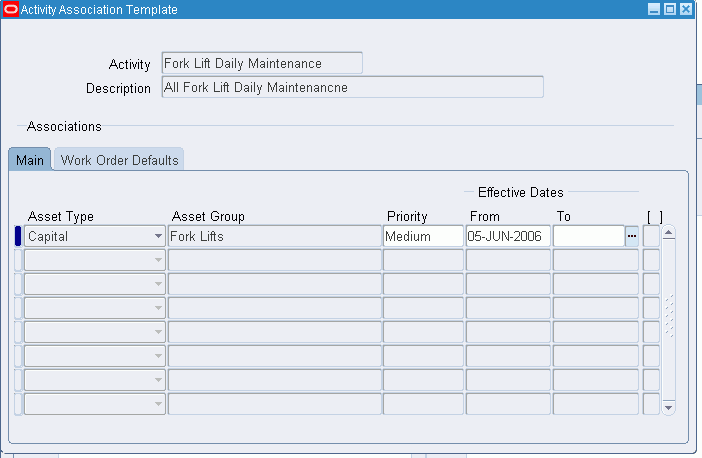You can streamline the creation of Activity associations using an Activity Association Template. For example, when you create an asset group, and then Asset Numbers within that group, you do not need to utilize the Association window to associate those Asset Numbers with an Activity. If you create an Activity Association Template, the Activity that you associate with asset group for the current Asset Number automatically determines the Activity that is associated with the current Asset Number.
Note: The Activity Workbench is generally used to streamline your Activity setups, including Activity Association Templates.
To create activity association templates
1. Navigate to the Activity Association Template window.

2. Select a valid Activity. The Activity needs to already have been created within the Master Item window.
3. Within the Main tab, select an Item Type of Asset or Rebuildable.
4. Select an Asset Group. After this record is saved, this asset group is associated with the current activity. Each asset number created within the current asset group is automatically associated with the current activity.
5. Optionally select a Priority code. This value defaults from the Master Activity information created within the Master Item window.
6. Optionally enter Effectivity Dates for this Activity Template.
7. Within the Work Order Defaults tab, optionally select an Activity Cause. This value specifies what situation caused this work to generate. For example, Breakdown, Vandalism, Normal Wear, or Settings. This value defaults from the Master Activity information created within the Master Item window.
8. Optionally select an Activity Type to indicate the type of maintenance for this Activity. It is used when defining a work order. It should remain generic, and should not describe the job in detail. For example, Inspection, Overhaul, Lubrication, Repair, Servicing, or Cleaning. This value defaults from the Master Activity information created within the Master Item window.
9. Optionally select the Tagging Required check box to indicate whether tag out procedures are required. The Area might need to be secured for operations required for carrying out a work order. Tags are generally printed and placed on an asset, warning the plant that the asset is shutdown, and should not be started. This check box helps the planner isolate those jobs that require a tagout. This is for informational purposes only.
10. Optionally select an Owning Department. This value defaults from the Enterprise Asset Management Parameters information for the current organization.
11. Optionally select a Shutdown Type to indicate whether a shutdown is necessary to perform this maintenance activity. For example Required, and Not Required. This field is for informational purposes. This value defaults from the Master Activity information that was created within the Master Item window.
12. Optionally select a WIP Accounting Class. This value defaults from the Enterprise Asset Management Parameters information for the current organization. See: Defining eAM Parameters, Oracle Enterprise Asset Management User's Guide.
13. Optionally select an Activity Source. Activity Source codes are reasons activities are executed. For example, Warranty Compliance, OSHA Compliance, or Military Specification Requirements. See: Activity Sources, Oracle Enterprise Asset Management User's Guide. This value defaults from the Master Activity information that was created within the Master Item window. See: Defining Activities, Oracle Enterprise Asset Management User's Guide.
13. Save your work.
Note: The Activity Workbench is generally used to streamline your Activity setups, including Activity Association Templates.
To create activity association templates
1. Navigate to the Activity Association Template window.

2. Select a valid Activity. The Activity needs to already have been created within the Master Item window.
3. Within the Main tab, select an Item Type of Asset or Rebuildable.
4. Select an Asset Group. After this record is saved, this asset group is associated with the current activity. Each asset number created within the current asset group is automatically associated with the current activity.
5. Optionally select a Priority code. This value defaults from the Master Activity information created within the Master Item window.
6. Optionally enter Effectivity Dates for this Activity Template.
7. Within the Work Order Defaults tab, optionally select an Activity Cause. This value specifies what situation caused this work to generate. For example, Breakdown, Vandalism, Normal Wear, or Settings. This value defaults from the Master Activity information created within the Master Item window.
8. Optionally select an Activity Type to indicate the type of maintenance for this Activity. It is used when defining a work order. It should remain generic, and should not describe the job in detail. For example, Inspection, Overhaul, Lubrication, Repair, Servicing, or Cleaning. This value defaults from the Master Activity information created within the Master Item window.
9. Optionally select the Tagging Required check box to indicate whether tag out procedures are required. The Area might need to be secured for operations required for carrying out a work order. Tags are generally printed and placed on an asset, warning the plant that the asset is shutdown, and should not be started. This check box helps the planner isolate those jobs that require a tagout. This is for informational purposes only.
10. Optionally select an Owning Department. This value defaults from the Enterprise Asset Management Parameters information for the current organization.
11. Optionally select a Shutdown Type to indicate whether a shutdown is necessary to perform this maintenance activity. For example Required, and Not Required. This field is for informational purposes. This value defaults from the Master Activity information that was created within the Master Item window.
12. Optionally select a WIP Accounting Class. This value defaults from the Enterprise Asset Management Parameters information for the current organization. See: Defining eAM Parameters, Oracle Enterprise Asset Management User's Guide.
13. Optionally select an Activity Source. Activity Source codes are reasons activities are executed. For example, Warranty Compliance, OSHA Compliance, or Military Specification Requirements. See: Activity Sources, Oracle Enterprise Asset Management User's Guide. This value defaults from the Master Activity information that was created within the Master Item window. See: Defining Activities, Oracle Enterprise Asset Management User's Guide.
13. Save your work.
No comments:
Post a Comment